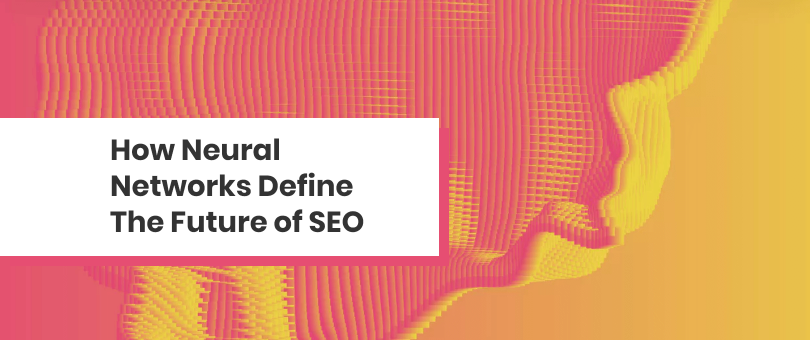Search engine optimization (SEO) is an anchor of modern entrepreneurship because half of the customers start looking for a brand using a search engine.
Google is particularly important here as it holds a search engine net share of almost 75%, but it dominates the rising mobile market even more with over 90%. However, the problem with website optimization is that Google’s algorithms keep changing.
Why does it happen?
The answer is “neural networks.”
A neural network is a series of algorithms that endeavors to recognize underlying relationships in a set of data through a process that mimics the way the human brain operates. This AI-based model is the cornerstone of machine learning that Google exploits to improve the user experience. But neural networks impact other processes, too.
The technology enables programmatic media buying, market analyses, customer service chatbots, product recommendations, and many other features. In this post, however, we will focus on optimization and show you how neural networks define the future of SEO. Let’s begin!
What Is DeepMind?

Before we begin describing how neural networks reshape search engine algorithms, we need to get you acquainted with DeepMind, an AI-focused company that Google acquired in 2014 for $600 million.
DeepMind is the global leader in AI research and its application for positive impact. They already improved the energy efficiency of Google’s data centers, reducing the electricity needed for cooling by up to 40%. However, the primary role of DeepMind is to develop neural networks.
Namely, the company is developing programs that can learn to solve any complex problem without needing to be taught how. They deal with a wide range of projects, the crucial ones being these:
- Massively Parallel Methods for Deep Reinforcement Learning
- Deep Reinforcement Learning in Large Discrete Action Spaces
- Adaptive Lambda Least-Squares Temporal Difference Learning
- Value-Decomposition Networks For Cooperative Multi-Agent Learning
- Risk-Constrained Reinforcement Learning with Percentile Risk Criteria
If this sounds very complicated, that’s because it is! However, their efforts result in highly practical benefits. Keep reading to learn how neural networks change the SEO universe.
How Neural Networks Influence SEO
Machine learning is able to delve deeper into the essence of website content. For this reason, it can come up with a new SEO formula and find a better way to rank web pages. It’s a complex process, but Google capitalizes on its immense advantages. Here are 8 ways neural networks influence SEO:
1. Content Improvements
AI makes the biggest impact on website content because it promotes quality over keyword stuffing. Back in the early days of Google, you could simply overload a post with keywords to maximize the SEO potential. However, times have changed and now you need to pay more attention to content quality and relevancy.
For instance, this is the reason why blog posts are getting longer. According to the study, the ideal length of a blog article is now 1.6 thousand words. An average user wants to read highly analytical posts that cover topics from all angles. The same goes for visual elements since you can no longer expect the audience to engage with generic stock photos or videos.
Everything you create and publish has to stand out from the crowd in order to earn a higher ranking. But if you are not able to deliver, neural networks will detect it and break down your ranking hopes.
2. Content-Driven Search Results
The second improvement goes hand in hand with the first one. Machine learning understands the context of each search query, so it can display results that perfectly correspond with the user’s needs. What does it mean?
It means that users get exactly what they are looking for. Let’s say you want to buy a new raincoat, but you specify the search by adding ‘blue’. In this case, AI will show you content-driven results that really lead to blue raincoats instead of just raincoats of any color.
It’s a simple but very clear example of content-driven search results. That way, the system ensures a higher level of personalization and makes it easier for the searcher to find relevant content.
3. Improved Algorithm Efficiency
You’ve probably figured out by now that neural networks strengthen search engine algorithms. Google is getting smarter with every iteration of user inquiries, thus improving the overall experience in the long run.
For instance, Google knows every book you’ve ever looked for online. Such knowledge enables search engines to provide you with more relevant results next time you start looking for a new book. It will suggest you authors who nurture similar styles or come from the same era.
Algorithms analyze the entire history of inquiries and locations, so the system is becoming more powerful over time. SEO is no longer based exclusively on keywords because contextual knowledge contributes even more to the relevancy of search results. In such circumstances, you can hardly ever outdo the system and earn top positions with irrelevant content.
4. On-Page Optimization

Speaking of improved ranking algorithms, we must also mention another segment of SEO: on-page optimization. Elements such as tags, metadata, or URLs traditionally played a very significant role in a website’s optimization strategy. But things have changed.
Although backlinks are not going to disappear, they will become less important. You might as well add dozens of links to your posts, but Google will know their true value and penalize you in case it’s irrelevant.
The system can analyze click-through rates, bounce rates, and other relevant indicators to determine backlink quality. Doing so, they protect users and provide them only with the most credible results.
As a webmaster, you will have to keep two things in mind:
- Backlinks must offer additional value because domain authority and relevancy still matters. If you can’t find quality backlinks, you better skip it.
- Content is much more important and therefore needs to be immaculate.
5. Webpage Testing

Measuring results is the only way to truly understand the productivity of a webpage. Unfortunately, only 44% of companies use split testing software to obtain the much-needed results. With machine learning, this process is easier than ever before.
An AI-powered system can automatically conduct the analysis to compare different options. For instance, you can design a landing page with two different headlines or any other elements within the page (product images, textual content, etc.). It will immediately display results and show you which options can rank higher or convert more leads.
In a world where 40% of marketers cite a conversion rate of less than 0.5%, it is essential to test your pages and identify advantages and shortcomings. Neural networks will soon give you the best model to do that, so make sure to stay up to date.
At the same time, it will help you to adjust user experience accordingly, which means you can decrease bounce rate in the long run. As a result, the SEO potential will also grow, so you can expect a higher ranking in the long-term perspective.
6. AI-Powered Advertising
Online advertising experienced one of the biggest improvements due to the data analysis potential of machine learning. First of all, recommendation engines are incredibly efficient while suggesting products to the target audience. They know exactly who to look for and what to offer, thus increasing ROI.
Secondly, the latest software solutions are able to detect spelling mistakes and make the necessary corrections. For example, you can write ‘blue taincoat’ instead of ‘blue raincoat’ but search engines will recognize the mistake and provide you with the right links.
Besides that, programmatic advertising allows real-time campaign optimization. The system is not using a bazooka to kill a mosquito, but trying to specialize. In terms of digital advertising, it means offering the right ads at the right time.
But that’s not all since neural networks also have the potential to predict the outcome of marketing campaigns. You can use these predictions to adjust content and improve different elements such as images, videos, or text, thus making your promo activities even more profitable.
7. Enhanced User Experience
![]()
This is the last item on our list, but it’s definitely not the least important. Enhanced user experience is the ultimate goal of machine learning in SEO and you probably noticed that each of the previous sections mentioned it one way or another.
According to the report, almost 40% of people will stop engaging with a website if the content or layout is unattractive. Since bounce rates strongly affect search engine ranking, you better make sure to utilize state of the art technology to improve the user experience.
If you know that two-thirds of users are looking to make a purchase the same day, then you realize how important it is to provide them with a personalized experience that meets their requirements. Using the neural network system, you will be on the verge of maximizing your SEO authority and earning new purchasers.
Conclusion
Website optimization can make or break the business, so it’s up to you to find the most productive SEO tactic. However, keep in mind that old strategies are no longer working because neural networks make a huge impact on search engine algorithms. You need to learn, adjust, and evolve, putting additional emphasis on content quality.
This article revealed how neural networks and machine learning define the future of SEO. You should embrace state of the art solutions and rearrange your website so as to fit the new requirements, but don’t hesitate to leave us a comment if you need more explanations about this subject.
Author bio: Golf lover, entrepreneur, and philanthropist. Bryan Brumfield is a full-time content marketing associate at BestEssays and a part-time blogger. His roots are in North Carolina, but his soul belongs in California. Bryan’s favorite pastime is playing chess and lip-syncing Rihanna’s songs. Check him out on Twitter.




